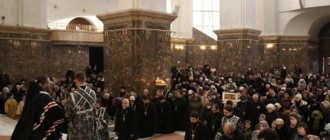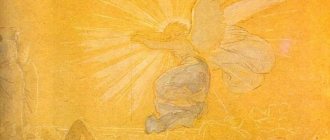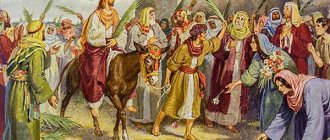Below you will find signs that people who have buried a loved one need to know - when you can open a mirror after the funeral, do cleaning and repairs, watch TV. There are many restrictions and prohibitions that were invented by our ancestors, for the most part, back in pre-Christian times.
Where is the soul of the deceased until 40 days?
Many people note that at first they feel the presence of a deceased person, which is manifested by smell, sighs, steps, and so on. This is due to the fact that for forty days the spirit does not leave the place where it lived.
- For the first three days the soul is free and it remembers its entire earthly life. It is believed that during this time she is in places that are close. On the third day after death, a memorial service must be held.
- After this there will be a meeting with God, the saints and a visit to heaven. From this moment, the first torment and fears begin that due to mistakes made, the entrance to heaven may be closed. All this lasts for six days, so on the ninth day a memorial service and wake are held.
- At the next stage, ordeals begin, which represent trials and obstacles. On the 40th day after death, the soul will receive a decision where it can spend eternal life in Heaven or Hell. During this period, a comparison of positive and negative actions occurs.
- Finding out what happens on the 40th day, it is worth mentioning the onset of the most important stage - the Last Judgment, where the soul can no longer influence anything and only the life of the deceased is taken into account.
ATTITUDE TO THE BEARD IN DIFFERENT RELIGIONS
Wearing a beard is prescribed by all major religions, except Buddhism, which adheres to the exact opposite point of view.
In Buddhism, monks, imitating Buddha, shave not only their beard, but their entire head - as a sign of renunciation of sensual pleasures and leading a righteous life. When Prince Siddhartha Buddha left home in search of the Path beyond death, old age and disease, he shaved his head hair and beard, and put on a saffron-colored robe. Thus, he got rid of the need to take care of his hair, and in addition, he demonstrated to others his attitude towards worldly things.
A shaved head in general is a symbol of submission, a renunciation of one’s own personality. Refusal of material goods, simplicity in everything is one of the ways to achieve nirvana. Every Buddhist strives for this state. There should be no distractions on the path to knowledge. Little things like washing your hair, drying and styling your hair take up a lot of time, which can be devoted to internal self-improvement. That's why Buddhist monks shave their heads.
Hinduism is one of the most unusual religions in the world, in which polytheism reaches incredible proportions - an innumerable number of gods and goddesses decorate the niches of the pantheon.
Three deities - Brahma, Vishnu and Shiva - are considered supreme. They constitute the concept of Trimurti, i.e. a triple image uniting Vishnu the omnipotent, Brahma the creator, and Shiva the destroyer.
According to the Puranas, in Hindu cosmology Brahma is considered the creator of the Universe, but not as God (on the contrary, he is believed to have been created by God). Brahma is often depicted with a white beard, symbolizing the almost eternal nature of his existence. Brahma's beard indicates wisdom and represents the eternal process of creation.
In the old days, Hindus smeared their beards with palm oil, and at night they put it in leather cases - beard covers. Sikhs wound their beards around a cord, the ends of which were tucked under the turban. On special occasions, the beard was spread out in a lush fan almost to the navel.
At the beginning of the 7th century, the prophet Muhammad, who began preaching in Mecca, defended the beard. He demanded that his followers grow beards. From the hadiths commenting on various statements of the prophet, it follows that he attributed a beard to what is natural for a person and, therefore, embodies God’s plan - since a beard grows, it means it must be worn.
Muhammad said: “Shave your mustache and grow your beard”; “Don't be like the pagans! Shave your mustache and grow your beard"; “Cut your mustache and grow your beard. Don’t be like fire worshipers!”
The Koran forbids shaving the beard. Shaving a beard is a change in the appearance of Allah's creation and submission to the will of Shaitan. Growing a beard is a natural property bestowed by Allah; touching it is not commanded and shaving it is prohibited. Muhammad said: “Allah has cursed men who imitate women.” And shaving a beard is likened to a woman.
One of the hadiths about the Prophet Muhammad says that he received an ambassador from Byzantium. The ambassador was clean-shaven. Muhammad asked the ambassador why he looked like that. The Byzantine replied that the emperor forces them to shave. “But Allah, He is Almighty and Great, ordered me to leave my beard and trim my mustache.” During the ensuing diplomatic conversation with the ambassador, Muhammad never looked at the shaven ambassador again because he treated him as an effeminate creature.
In Islam, a beard is an obligation and cutting it completely is prohibited. However, there are cases where shaving the beard is permitted (for example, if you are traveling to a country where wearing a beard may result in persecution). But be that as it may, prolonged shaving of the beard is a great sin (kabira).
In Judaism, a shaved beard is considered a loss of honor (2 Kings 10:4-6, 1 Chronicles 19:4-6, etc.). For example, in Hasidism, removing a beard is tantamount to a formal break with the community.
The Torah forbids cutting your beard: “Do not cut your head round, and do not spoil the edges of your beard.” Therefore, the Jews, zealously faithful to the laws of the Torah, did not shave their beards. The Torah's prohibition against “destroying” a beard applies (of course) only to the use of a razor blade of any type. The issue of “trimming” or “shaving” the beard has been and remains the subject of debate among rabbis (there are authorities who allow “shave” of the beard with scissors and an electric razor, and there are also authorities who believe that these methods are strictly prohibited).
In the Tanakh, shaving the beard is mentioned as a sign of mourning or humiliation.
The Talmud mentions the prohibition against shaving the beard as one of the protective measures against assimilation. By the way, it was in the Talmud that the beard was first mentioned as an integral element of male beauty (“Bava Metzia” 84a). According to the customs of Judaism, Orthodox Jews wear sidelocks (long untrimmed strands of hair at the temples), a beard and, of course, a headdress.
In modern times, with the spread of Kabbalah, the ban on shaving the beard has already acquired a mystical meaning. For example, according to the teachings of Kabbalah, the entire created world is a material reflection of the Almighty. Moreover, a person is, to some extent, a reflection of the Almighty in the material world. Each part of the human body corresponds in the spiritual world to a certain aspect of the manifestation of the Almighty. It turns out that a person without a beard is an incomplete person; by shaving his beard, he moves away from the Creator, loses the Divine “image and likeness” to the Almighty.
But, at the same time, it is believed that a Jew who does not yet feel that he is on a high enough spiritual level to do everything that is required by Kabbalah should not be afraid to shave. And he can safely do this on all days of the week (of course, except Saturday).
Common to all Jews (including non-religious ones) is the custom of not shaving their beards for a month as a sign of mourning for a close relative.
CATHOLICISM
Catholic clergymen are ordered not to have a free-growing beard: Clericus nec comam nutriat nec barbam. The interpretation of this prescription was different in different periods. It is known that from the 16th to the 18th centuries many Popes had beards! (Julius II, Clement VII, Paul III, Julius III, Marcellus II, Paul IV, Pius IV, Pius V).
Pope Julius II was the first to grow a beard in 1511. Despite the fact that his most famous portrait is with a beard, he did not break the custom for long - only for a year. He grew his beard as a sign of grief. After him, several more dads did not even think about wild facial hair.
However, the resonance of Julius II's actions was felt throughout the years, and Pope Clement VII grew a luxurious beard in 1527, which he did not shave until his death in 1534. He was treacherously poisoned, feeding the unsuspecting pontiff pale toadstool for sympathy with France.
Subsequent Popes decided that a beard was beautiful and pleasing to God and proudly wore facial hair for more than two centuries. Pope Alexander XVII, however, gave his beard a refined and more modern shape (mustache and goatee, the same shape of beard and mustache was followed by subsequent Popes) - his papacy lasted from 1655 to 1667.
Pope Clement XI interrupted the glorious tradition (note that Clement VII started it). He ascended the throne on November 23, 1700.
In general, at first in the Roman Church there were no canonical rules regarding whether to wear a beard or not, and earlier Popes considered it their duty to grow a beard - starting from the Apostle Peter, few of them even thought about shaving their facial hair. This was the case until the Great Schism in 1054.
Even in ancient times, the Romans were accustomed to seeing a beard as a symbol of barbarism. Perhaps this was the reason for the penchant of Catholic clerics for a clean shave.
In the Western Church, one of the symbols of priestly service was tonsure - hair cut in a circle on the top of the head.
In Catholicism, a clergyman is required to shave his beard - a smooth face is considered a symbol of holiness, and in some monastic orders tonsure is also accepted - a shaved nape.
ORTHODOXY
In Orthodoxy, on the contrary, it is a thick beard that indicates priestly status.
Russian saints. Detail. From left to right Anthony of Pechersky, Sergius of Radonezh, Theodosius of Pechersky
From the point of view of Orthodox customs, a beard is a detail of the image of God.
Shaving a beard (barber shaving) is one of the serious sins according to Orthodox teaching. In Orthodoxy it has always been illegal, i.e. violating the Law of God and the institutions of the Church. Shaving was prohibited in the Old Testament (Leviticus 19:27; 2 Samuel 10:1; 1 Chronicles 19:4); it is prohibited both by the rules of the VI Ecumenical Council (see interpretation on the 96th rule of Zonar and the Greek Helmsman Pidalion), and by many patristic writings (the works of St. Epiphanius of Cyprus, St. Cyril of Alexandria, Blessed Theodoret, St. Isidore Pilusiot). Condemnation of barber shaving is also contained in Greek books (works of Nikon of the Black Mountain, f. 37; Nomocanon, pr. 174). The Holy Fathers believe that someone who shaves his beard expresses dissatisfaction with his appearance, which was given to him by the Creator, and tries to “edit” Divine institutions. About the same rule 96 of the cathedral in Trulla Polatne “about the cutting of hair.”
Decrees of the saints Apostle: “Nor should one spoil the hair on the beard and change the image of a person contrary to nature. Do not bare, says the law, your beards. For the Creator God made this (being without a beard) beautiful for women, but He declared it obscene for men. But you, who bare your beard in order to please, as one who resists the law, will be an abomination to God, who created you in his own image.”
During the Great Schism in 1054, the Patriarch of Constantinople, Michael Cerullarius, in a letter to the Patriarch of Antioch, Peter, accused the Latins of other heresies and of “cutting off the brada.” The same accusation is confirmed by the Russian Rev. Father Theodosius of Pechersk in his “Sermon on the Christian and Latin Faith.”
Shaving the beard (barber shaving) is strictly prohibited, as is the Latin custom. The one who follows him must be excommunicated from church communion (Lev. 19, 27; 21, 5; Stoglav, Chapter 40; Helmsman of Patriarch Joseph. Rule of Nikita Scythitis “On tonsure of marriage,” fol. 388 on the ver. and 389).
In Russia, wearing a beard was enshrined in the decisions of the Stoglavy Council. The Hundred-Glavy Council of the Russian Church (1551) determined: “if anyone shaves his hair and reposes in this way (i.e., without repenting of this sin), he is not worthy to serve over him, neither sing the magpie for him, nor prosvira, nor send a candle for him to the church bring, with the infidels, it will be due, from the heretic, he has become a habit” (i.e., if one of those who shave his beard dies, a funeral should not be served over him, nor should he sing the magpie, nor should he bring bread or candles to the church for his commemoration; for he is considered infidel because he learned this from heretics).
Old Believers still believe that without a beard it is impossible to enter the Kingdom of Heaven, and they forbid a shaven person to enter the church, and if an Old Believers living “in the world” shaved and did not repent of it before his death, he is buried without performing a funeral rite.
In the Holy Scriptures it is said about the beard: “... no shave shall come upon your hair,” or, to make it clear, you cannot trim your beard. If we believe in God, then we must understand that He created us as He saw fit. Shaving means not resigning to the will of God, but when we read “Our Father” every day, we repeat: “Thy will be done.” The Lord divided people into two ranks - men and women, and each commanded his own: men should not change their faces, but should cut the hair on their heads, and women should not cut their hair.
For an Orthodox Christian, a beard has always been a symbol of faith and self-respect. The ancient Russian Church strictly forbade barber shaving, seeing in it an outward sign of heresy, a falling away from Orthodoxy.
The basis for the custom of wearing long hair among the Orthodox clergy was found in the Old Testament, where a special order of Nazirites was established, which was a system of ascetic vows, among which was the prohibition of cutting hair (Num. 6:5; Judges 13:5). In this regard, the fact that in the Gospel Jesus Christ is called a Nazarite is given special weight.
His lifetime image (the “Savior Not Made by Hands” icon) was also considered evidence of the special length of the Savior’s hair; The image of Jesus Christ with his hair flowing over his shoulders is traditional in iconography.
Until the time of Peter I, cutting the beard and mustache was considered a grave sin and was compared to sodomy and adultery, punishable by excommunication from the Church. The prohibition to shave the Beard was explained by the fact that man was created in the likeness of God and, therefore, it is sinful to distort this appearance in any way by one’s will.
The hairs on the heads of Christ's disciples are all numbered by God (Matthew 10:30; Luke 12:7).
The tradition of Orthodox priests to wear a beard
In modern Russia (before and throughout the Orthodox world), the wearing of a beard by priests is a good, centuries-old tradition that is preserved by the Orthodox Church. The beards of Orthodox clergy remain an important distinguishing feature.
The priest of the Orthodox Church is the bearer of the image of Christ. Jesus Christ gave us an example of wearing a beard. He passed on this tradition to His apostles, and they, in turn, to their disciples, and to others, and this chain has continuously reached us.
The custom of Orthodox priests wearing beards dates back to the Old Testament tradition. The Bible says this definitely: “And the Lord said to Moses: announce to the priests, the sons of Aaron, and tell them... They must not shave their heads and trim the edges of their beard and make cuts on their bodies.” (Lev.21:1,5) . Or in another place: “And the Lord spoke to Moses, saying, Proclaim to all the congregation of the children of Israel, and tell them. Do not cut your head round, and do not spoil the edges of your beard. For the sake of the deceased, do not make cuts on your body and do not inscribe writings on yourself.” (Lev. 19:1,2,27-28).
Jeremiah 1:30 says: “And in their temples sat priests with torn clothes, with shaved heads and beards, and with their heads uncovered.” This quote is for priests. As we see, a priest should under no circumstances shave his beard, otherwise he becomes like the pagan priests who sit “in the temples.” with shaved heads and beards."
And don’t be confused by the fact that all quotes are taken from the Scriptures of the Old Testament: the Lord Himself said that He came not to break the Law, but to fulfill it.
However, today, it seems, the controversy surrounding bro-shaving has subsided - the time has come for stabilization. Priests are given greater freedom in choosing the shape and length of their beard.
As for the laity, today most of them do not wear a beard. This indicates a lowering of the bar for the spiritual life of modern man. Nowadays, wearing a beard is more of a fashion trend than any religious reasons. Is it correct? – another question.
Material prepared by Sergey SHULYAK
The following literature was used in preparing the material:
1. V.A. Sinkevich “The Beard in the History of Christianity”
2. “The History of the Beard and Mustache” (publications in the historical and literary magazine “Historical Bulletin”, 1904)
3. Giles Constable “Beards in History. Symbols, fashions, perception"
4. B. Bellevoussky “Apology for the Beard”
Is it obligatory not to shave during the period of Sephirat Ha-Omer?
Almost 1900 years ago, a great misfortune happened: a terrible epidemic claimed the lives of many Jews. And at the very beginning of this epidemic, hundreds and thousands of students of Rabbi Akiva died. This happened after the Passover holiday. The epidemic lasted 33 days.
Our Teachers did not limit themselves to simply stating the natural causes of death and saw in this a manifestation of spiritual shortcomings. What spiritual shortcomings could such serious and worthy people as the disciples of Rabbi Akiva have?
The teachers concluded that they did not give each other enough credit. They did not rejoice at the successes of their comrades in spiritual growth as they did their own.
Can a seemingly insignificant “detail” lead to such a large-scale tragedy?
As it turns out, it can. If it becomes an obstacle to a person’s spiritual growth. And what we are talking about is exactly such a case. After all, this means that the sense of integrity and unity of the people of Israel has weakened, which leads to a weakened awareness of the essence of the Creator.
The roots of this tragedy have not yet been corrected. And therefore, during this period, starting from the first day after the holiday of Passover, we observe (not completely) the laws of mourning.
In particular, there is a custom not to shave (or cut hair).
It is customary for Ashkenazi Jews not to shave from the beginning of Passover until the 3rd Sivan (three days before the holiday of Shavuot). However, you can shave on the day of Lag B'Omer (33rd day of the Omer)
Sephardic Jews also do not shave from the beginning of Passover until the full 33 days. Therefore, they cannot shave on Lag B'Omer yet and do it the next day. And then they shave as usual.
Are there exceptions, or rather, relaxations?
Exist. But only on an individual basis.
I will give examples of several of the most common situations.
1. If a person works in a place where his position requires a neat appearance and he must always be clean-shaven. It is important to make sure that this is really the case.
2. When parents or wife object to the “beard”. There is no need to “break spears” about this. However, efforts should be made so that next year they can understand how important it is for you (and all the people) to observe this custom.
3. If a person has very delicate skin and changes (a person shaves or doesn’t shave), irritation occurs on it (acne, red spots, etc.). However, as a rule, this obstacle can be overcome. You should consult your doctor.
In each of the three cases, you need to consult with a rabbi who has experience and can help solve such problems. Indeed, in each specific case, the decision must take into account the circumstances and personality characteristics of the person who has this or that problem.
And two more notes.
It is best for an adult man not to cut his beard at all (only trim it in places where it is necessary). Naturally, I do not want to say that this is the responsibility of every Jew. However, anyone who is serious about Torah knows that this is the right decision for him.
And one last thing. The prohibition on cutting hair during the counting of the Omer applies only to men.
How to pray for the deceased for up to 40 days?
Remembering dead people is the duty of every believer. According to the church, you need to pray especially diligently during the first forty days after death. A prayer for 40 days to see off the soul can be said in church or at home. If a person chooses the second option, then it is recommended that women tie a scarf on their heads and light candles in front of the image of the Lord. When figuring out the rules of 40 days after death and how to remember, it is worth noting that prayer during this period helps to gain faith in the soul and more easily cope with the loss of a loved one.
“Son of God, Lord Jesus Christ. Satisfy my heartfelt grief for the deceased slave (name of the deceased). Help me cope with this difficult loss, and give me strength to withstand the grief. And on the fortieth tribulation day, accept the soul of the deceased (name of the deceased) into the Kingdom of Heaven. And it will be so now, forever, forever and ever. Amen".
Common traditions
Funeral prayers can be read at home every day. But there are forbidden days for a memorial service:
- last week before Easter;
- Easter Sunday;
- Christmas;
- twelve holidays.
On holidays, the priest can make an exception and, at the request of relatives, read a litiya - a prayer in the vestibule of the church. Litiya can be read independently at home or at the burial place of the deceased for forty days.
An ancient tradition is to dine at funerals with wooden spoons. The devices are placed with their backs facing up. Sharp knives and forks are not used when setting the table. Funerals are allowed to be held earlier or later than the fortieth day.
Orthodoxy does not approve of the funeral custom of leaving a glass of vodka on the grave. Alcohol can be placed on the windowsill at home. If the glass is empty in the morning, it means that the soul of the deceased has accepted the offering. Crumbs from the funeral dinner are brought to the person’s resting place.
Is it possible to remember 40 days earlier?
Life is unpredictable and it is often not possible to carry out planned events. The clergy say that if it is not possible to remember the deceased on the 40th day, it is not a tragedy or a sin, since this can be done in advance or even later. It is forbidden to reschedule commemoration at liturgy, memorial service and cemetery. Many people are still interested in how to count 40 days from the date of death, so the first day is the day of death itself, even if the death occurred late in the evening before midnight.
What is prepared for 40 days after death?
On this day, a memorial dinner is always held, the purpose of which is to remember the deceased and pray for his repose. It is important to remember that food is not the main thing, so there is no need to try to prepare a luxurious menu with a lot of delicacies. A funeral dinner for 40 days, the menu of which should take into account the rules of Christianity, implies adherence to several important principles:
- On the table there should be kutia, which is made from millet or rice, and pancakes without filling. Each of these dishes has its own important sacred meaning, which helps to appreciate the frailty of existence.
- For those who are interested in the topic - 40 days after death, how to remember, you need to know about the ancient tradition of baking pies with different fillings.
- If the forties did not fall during Lent, then meat dishes are not prohibited, so you can serve cutlets, cabbage rolls, goulash as a side dish, and so on.
- Various fish dishes are allowed, and these can be first and second courses.
- You can put salads on the table that include lean ingredients in the recipe.
- Understanding the traditions of 40 days after death and how to remember the deceased, it is worth mentioning that in many families it is customary to follow the tradition of preparing the deceased’s favorite dish for a funeral dinner.
- As for desserts, it is best to make cheesecakes, pies, cookies, and sweets are also allowed.
What do they take to the cemetery for 40 days?
According to traditions, on memorial days, people go to the cemetery to say goodbye to a loved one. You need to take flowers with you to the grave, of which there should be a pair, and a candle. With these objects, the living can express their respect to the deceased. You cannot talk loudly at the grave, have snacks, and especially drink alcohol. Another important point regarding what is brought to the cemetery for 40 days is that as a treat for the deceased, you can take a plate of kutya from home and leave it at the grave.
Rules and procedures for holding funerals at home
The funeral fortieth day begins with a visit to the morning service in the church and cemetery. Flowers are brought to the grave and candles are lit to show respect to the deceased relative. Noisy feasts in the fresh air are not welcome. It is enough to sit on a bench and pray. You can also leave a saucer with kutya, cookies and sweets at the monument.
After the cemetery, the family of the deceased invites relatives and friends home for dinner. The first dish is kutia, a traditional porridge.
During the meal, funeral speeches are made. Close relatives speak first: parents, children, spouses, sisters and brothers. You can also invite a priest from the church that the deceased attended to lunch and ask him to read a sermon.
Funeral etiquette for the forties:
- jokes and laughter are not appropriate in the cemetery and at the table;
- discussion of work, family matters, issues of division of inheritance between relatives should be postponed until after the event;
- people come to the wake only by invitation;
- They leave a free place at the table for the deceased and place his portrait tied with a black ribbon.
People leave the event in honor of the forties in reverse order: colleagues and friends say goodbye first, leaving close relatives to finish the meal in a close circle.
How to dress for a wake for men:
- classic suit - black, dark brown or dark blue;
- light shirt;
- a tie of one color or with a small, unobtrusive pattern;
- without headdress.
Military personnel wear a dark dress uniform.
What to wear for women on their 40th birthday:
- midi length dress or skirt, below the knees;
- on top - a dark or light blouse or jacket;
- cover your head with a scarf, a hat with a veil, they can be removed indoors;
- gather hair into a neat bun, ponytail without shiny clips;
- For jewelry, you can leave a wedding ring and a pectoral cross.
It is not customary to give gifts or money at a funeral. The purpose of the event is the spiritual unity of loved ones. To express respect for the deceased and condolences to the family, a memorial speech at the table is enough. But you need to choose your words delicately. To acquaintances and colleagues it is enough to say a short phrase. If Christian believers have gathered around the table, it would be appropriate to recall the lines of the Bible and the sayings of the holy righteous.
Funeral service for 40 days – when to order?
On the fortieth day of commemoration of the deceased, you must definitely go to the temple, where you can pray and order a memorial service and magpie.
- The most important prayer is said at the liturgy. During this, a bloodless sacrifice must be made to the Lord.
- Seeing off the soul on the 40th day necessarily includes a memorial service and this ritual is served in front of a special table called the eve. Gifts are left there for the needs of the temple and in memory of the dead. If a memorial service is not scheduled on the day that falls, then a litany is held for the deceased.
- Understanding the topic - 40 days after death, how to commemorate, it is necessary to say that it is important to order the magpie, which is carried out from the day of death until the 40th day. When the allotted time is over, the sorokoust can be repeated one more time. Longer memorial times can be ordered.











